Improving Patient Outcomes: Health Education During Hospital Discharge
VerifiedAdded on 2023/06/04
|20
|4794
|345
Report
AI Summary
This report, based on the author's nursing experience, examines the critical role of health education in the hospital discharge process. It highlights the importance of comprehensive discharge planning, including medication management, caregiver education, and follow-up care. The report identifies gaps and deficiencies in current practices, such as delays in discharge, insufficient patient and caregiver engagement, and poor coordination between hospital and post-discharge services. It emphasizes the need for improved communication, early assessment, and proactive strategies to ensure patient understanding and adherence to treatment plans. Recommendations include providing written materials, simplifying medication regimens, and establishing clear communication channels. The report stresses the importance of addressing these issues to enhance patient outcomes, reduce readmissions, and improve the overall quality of care.
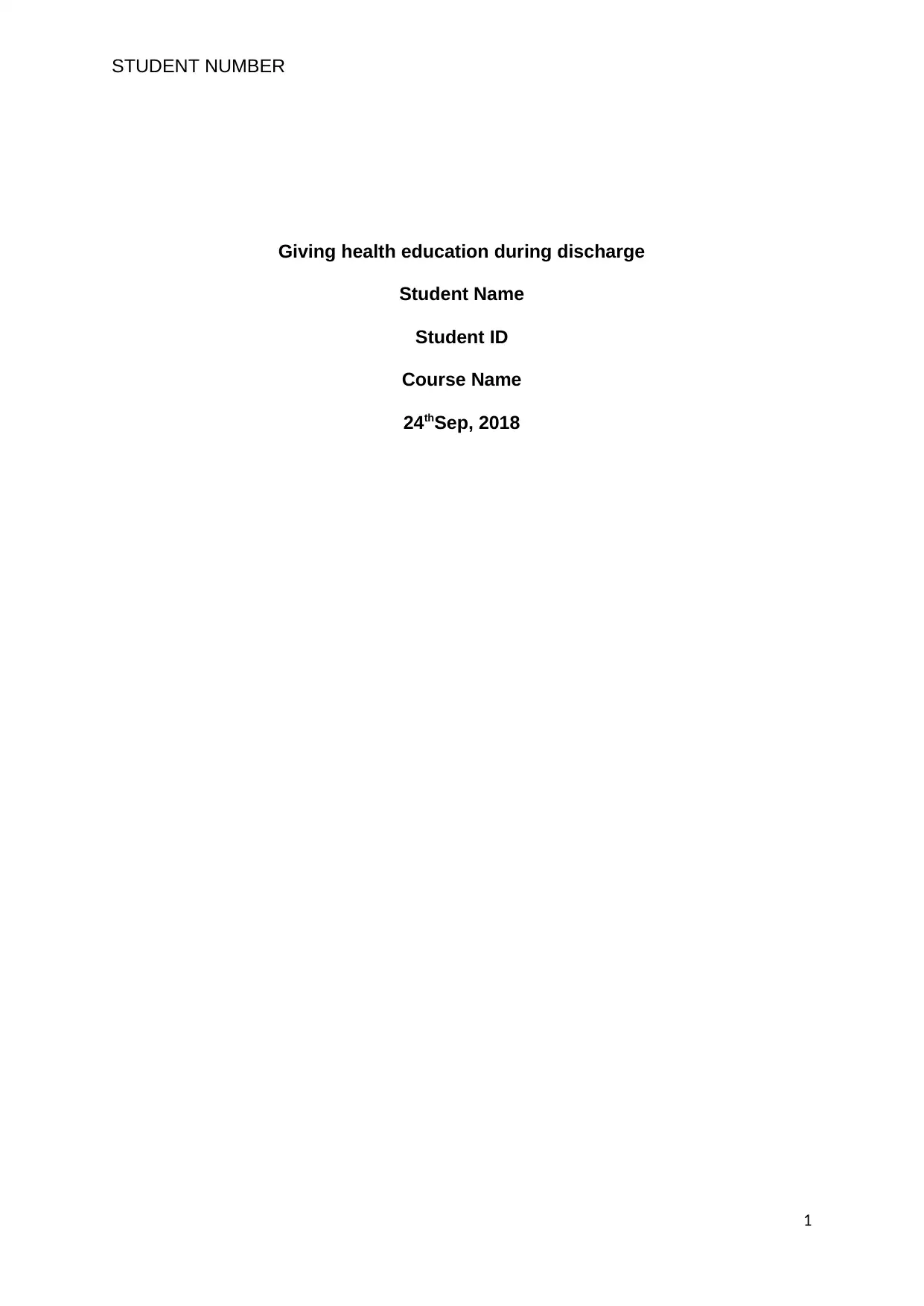
STUDENT NUMBER
Giving health education during discharge
Student Name
Student ID
Course Name
24thSep, 2018
1
Giving health education during discharge
Student Name
Student ID
Course Name
24thSep, 2018
1
Paraphrase This Document
Need a fresh take? Get an instant paraphrase of this document with our AI Paraphraser
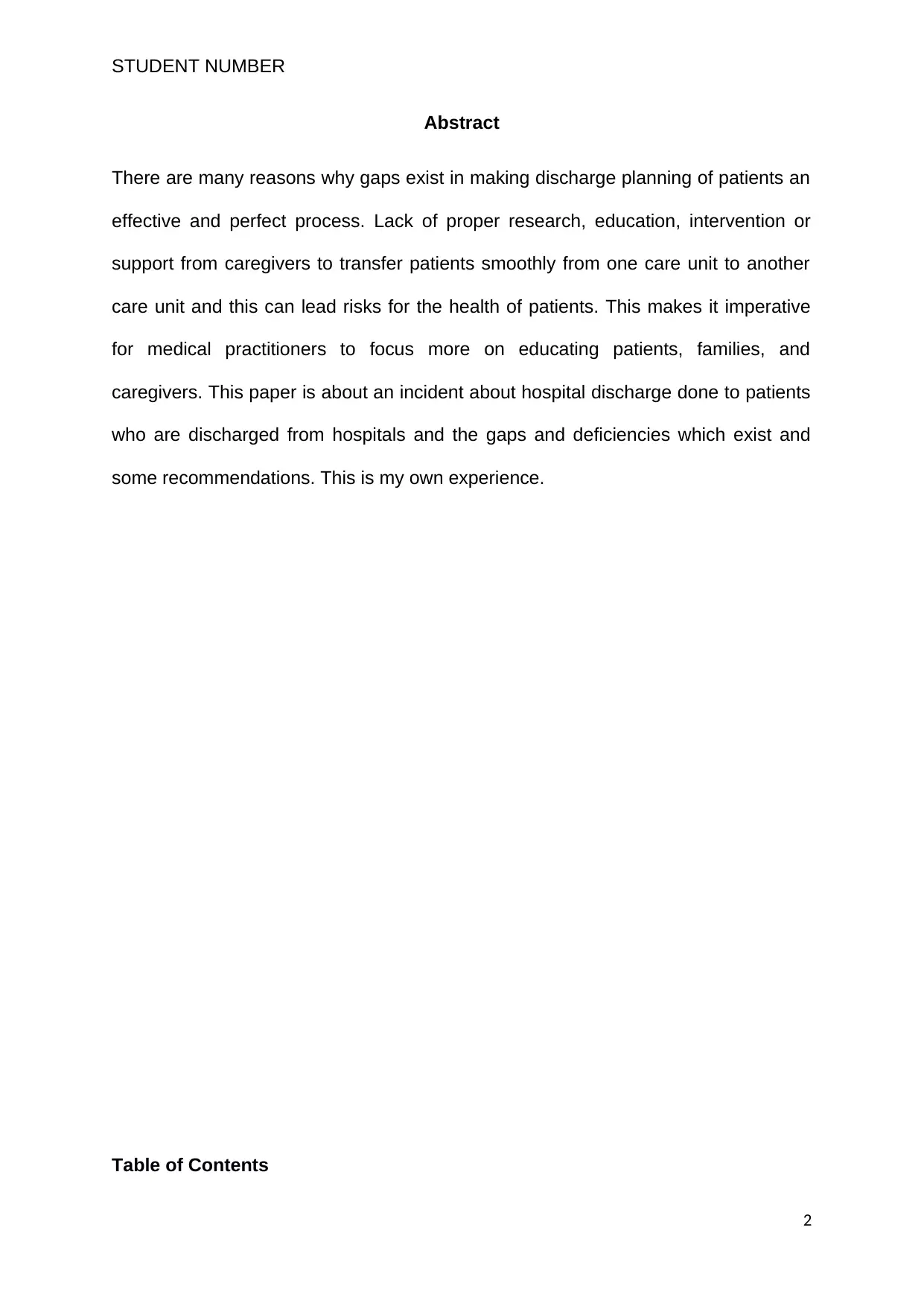
STUDENT NUMBER
Abstract
There are many reasons why gaps exist in making discharge planning of patients an
effective and perfect process. Lack of proper research, education, intervention or
support from caregivers to transfer patients smoothly from one care unit to another
care unit and this can lead risks for the health of patients. This makes it imperative
for medical practitioners to focus more on educating patients, families, and
caregivers. This paper is about an incident about hospital discharge done to patients
who are discharged from hospitals and the gaps and deficiencies which exist and
some recommendations. This is my own experience.
Table of Contents
2
Abstract
There are many reasons why gaps exist in making discharge planning of patients an
effective and perfect process. Lack of proper research, education, intervention or
support from caregivers to transfer patients smoothly from one care unit to another
care unit and this can lead risks for the health of patients. This makes it imperative
for medical practitioners to focus more on educating patients, families, and
caregivers. This paper is about an incident about hospital discharge done to patients
who are discharged from hospitals and the gaps and deficiencies which exist and
some recommendations. This is my own experience.
Table of Contents
2
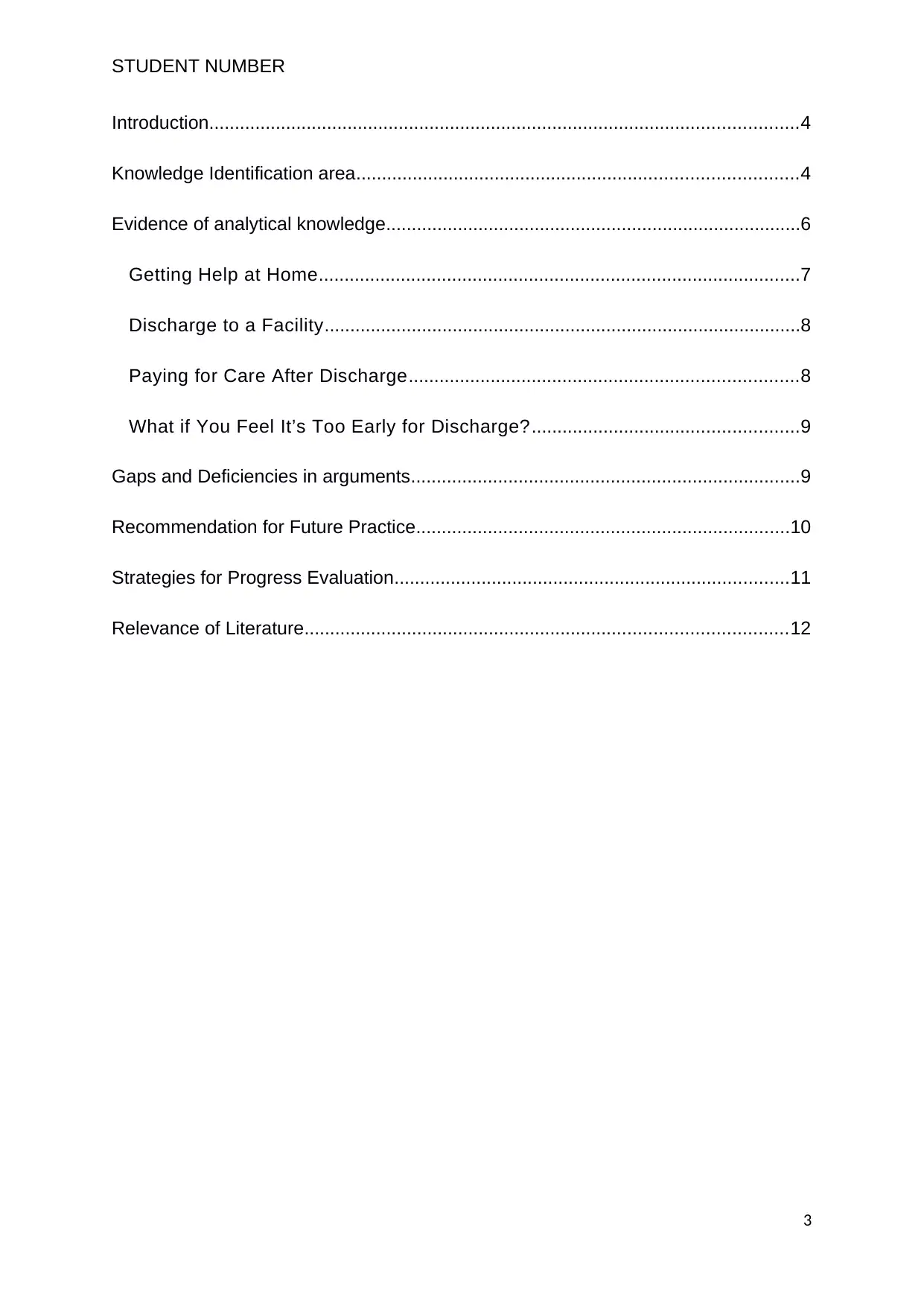
STUDENT NUMBER
Introduction...................................................................................................................4
Knowledge Identification area......................................................................................4
Evidence of analytical knowledge.................................................................................6
Getting Help at Home..............................................................................................7
Discharge to a Facility.............................................................................................8
Paying for Care After Discharge............................................................................8
What if You Feel It’s Too Early for Discharge?....................................................9
Gaps and Deficiencies in arguments............................................................................9
Recommendation for Future Practice.........................................................................10
Strategies for Progress Evaluation.............................................................................11
Relevance of Literature..............................................................................................12
3
Introduction...................................................................................................................4
Knowledge Identification area......................................................................................4
Evidence of analytical knowledge.................................................................................6
Getting Help at Home..............................................................................................7
Discharge to a Facility.............................................................................................8
Paying for Care After Discharge............................................................................8
What if You Feel It’s Too Early for Discharge?....................................................9
Gaps and Deficiencies in arguments............................................................................9
Recommendation for Future Practice.........................................................................10
Strategies for Progress Evaluation.............................................................................11
Relevance of Literature..............................................................................................12
3
⊘ This is a preview!⊘
Do you want full access?
Subscribe today to unlock all pages.

Trusted by 1+ million students worldwide
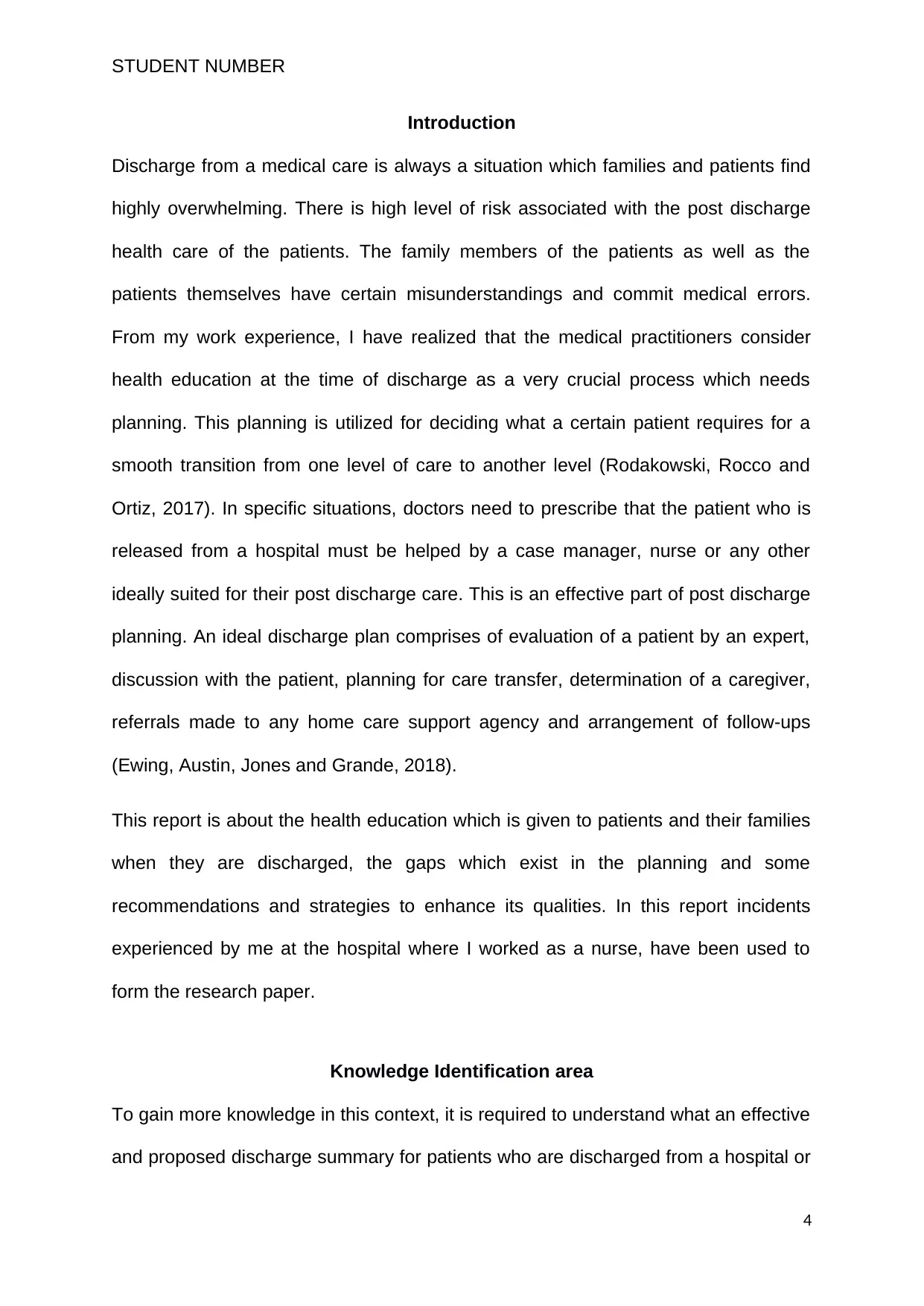
STUDENT NUMBER
Introduction
Discharge from a medical care is always a situation which families and patients find
highly overwhelming. There is high level of risk associated with the post discharge
health care of the patients. The family members of the patients as well as the
patients themselves have certain misunderstandings and commit medical errors.
From my work experience, I have realized that the medical practitioners consider
health education at the time of discharge as a very crucial process which needs
planning. This planning is utilized for deciding what a certain patient requires for a
smooth transition from one level of care to another level (Rodakowski, Rocco and
Ortiz, 2017). In specific situations, doctors need to prescribe that the patient who is
released from a hospital must be helped by a case manager, nurse or any other
ideally suited for their post discharge care. This is an effective part of post discharge
planning. An ideal discharge plan comprises of evaluation of a patient by an expert,
discussion with the patient, planning for care transfer, determination of a caregiver,
referrals made to any home care support agency and arrangement of follow-ups
(Ewing, Austin, Jones and Grande, 2018).
This report is about the health education which is given to patients and their families
when they are discharged, the gaps which exist in the planning and some
recommendations and strategies to enhance its qualities. In this report incidents
experienced by me at the hospital where I worked as a nurse, have been used to
form the research paper.
Knowledge Identification area
To gain more knowledge in this context, it is required to understand what an effective
and proposed discharge summary for patients who are discharged from a hospital or
4
Introduction
Discharge from a medical care is always a situation which families and patients find
highly overwhelming. There is high level of risk associated with the post discharge
health care of the patients. The family members of the patients as well as the
patients themselves have certain misunderstandings and commit medical errors.
From my work experience, I have realized that the medical practitioners consider
health education at the time of discharge as a very crucial process which needs
planning. This planning is utilized for deciding what a certain patient requires for a
smooth transition from one level of care to another level (Rodakowski, Rocco and
Ortiz, 2017). In specific situations, doctors need to prescribe that the patient who is
released from a hospital must be helped by a case manager, nurse or any other
ideally suited for their post discharge care. This is an effective part of post discharge
planning. An ideal discharge plan comprises of evaluation of a patient by an expert,
discussion with the patient, planning for care transfer, determination of a caregiver,
referrals made to any home care support agency and arrangement of follow-ups
(Ewing, Austin, Jones and Grande, 2018).
This report is about the health education which is given to patients and their families
when they are discharged, the gaps which exist in the planning and some
recommendations and strategies to enhance its qualities. In this report incidents
experienced by me at the hospital where I worked as a nurse, have been used to
form the research paper.
Knowledge Identification area
To gain more knowledge in this context, it is required to understand what an effective
and proposed discharge summary for patients who are discharged from a hospital or
4
Paraphrase This Document
Need a fresh take? Get an instant paraphrase of this document with our AI Paraphraser
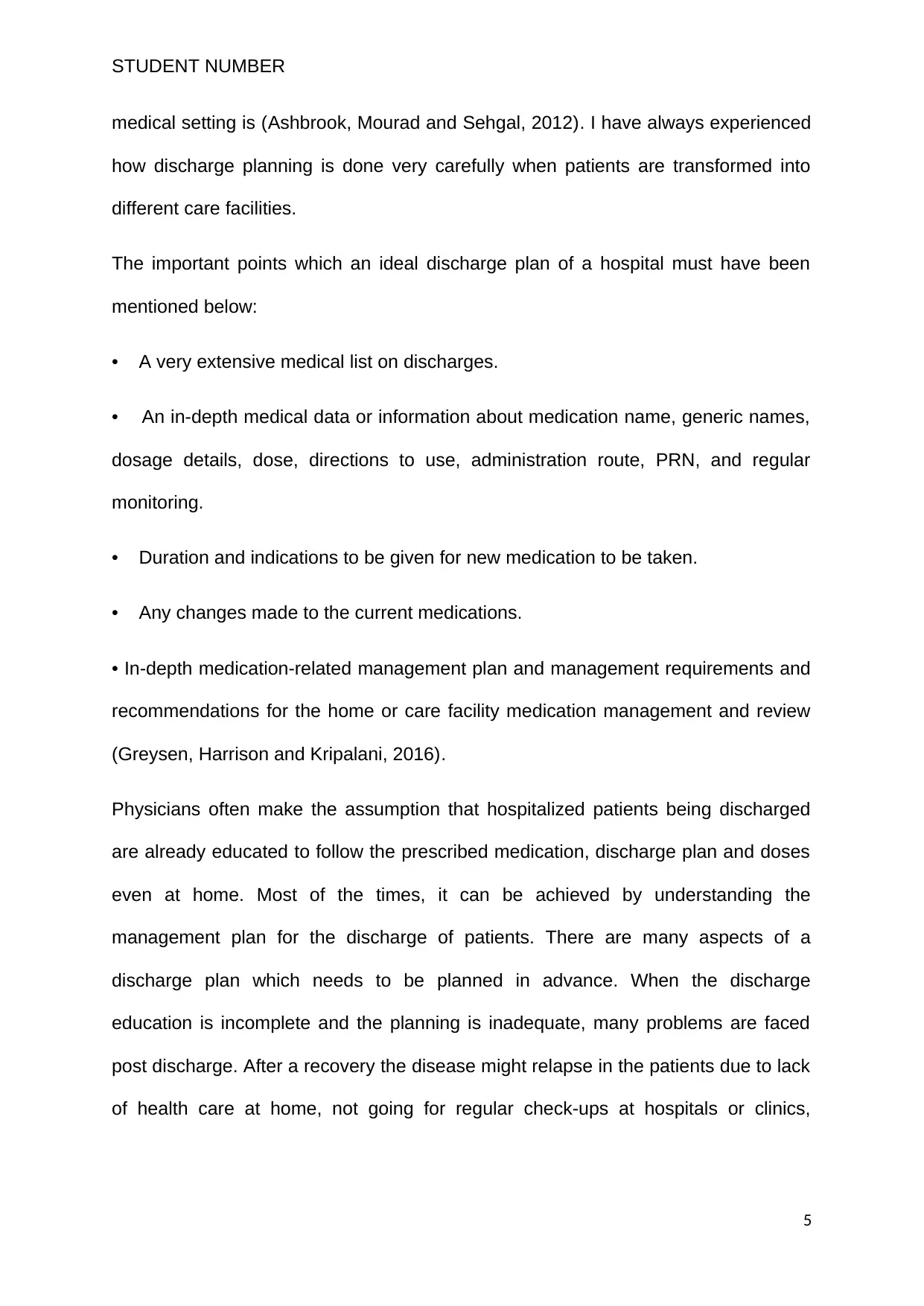
STUDENT NUMBER
medical setting is (Ashbrook, Mourad and Sehgal, 2012). I have always experienced
how discharge planning is done very carefully when patients are transformed into
different care facilities.
The important points which an ideal discharge plan of a hospital must have been
mentioned below:
• A very extensive medical list on discharges.
• An in-depth medical data or information about medication name, generic names,
dosage details, dose, directions to use, administration route, PRN, and regular
monitoring.
• Duration and indications to be given for new medication to be taken.
• Any changes made to the current medications.
• In-depth medication-related management plan and management requirements and
recommendations for the home or care facility medication management and review
(Greysen, Harrison and Kripalani, 2016).
Physicians often make the assumption that hospitalized patients being discharged
are already educated to follow the prescribed medication, discharge plan and doses
even at home. Most of the times, it can be achieved by understanding the
management plan for the discharge of patients. There are many aspects of a
discharge plan which needs to be planned in advance. When the discharge
education is incomplete and the planning is inadequate, many problems are faced
post discharge. After a recovery the disease might relapse in the patients due to lack
of health care at home, not going for regular check-ups at hospitals or clinics,
5
medical setting is (Ashbrook, Mourad and Sehgal, 2012). I have always experienced
how discharge planning is done very carefully when patients are transformed into
different care facilities.
The important points which an ideal discharge plan of a hospital must have been
mentioned below:
• A very extensive medical list on discharges.
• An in-depth medical data or information about medication name, generic names,
dosage details, dose, directions to use, administration route, PRN, and regular
monitoring.
• Duration and indications to be given for new medication to be taken.
• Any changes made to the current medications.
• In-depth medication-related management plan and management requirements and
recommendations for the home or care facility medication management and review
(Greysen, Harrison and Kripalani, 2016).
Physicians often make the assumption that hospitalized patients being discharged
are already educated to follow the prescribed medication, discharge plan and doses
even at home. Most of the times, it can be achieved by understanding the
management plan for the discharge of patients. There are many aspects of a
discharge plan which needs to be planned in advance. When the discharge
education is incomplete and the planning is inadequate, many problems are faced
post discharge. After a recovery the disease might relapse in the patients due to lack
of health care at home, not going for regular check-ups at hospitals or clinics,
5
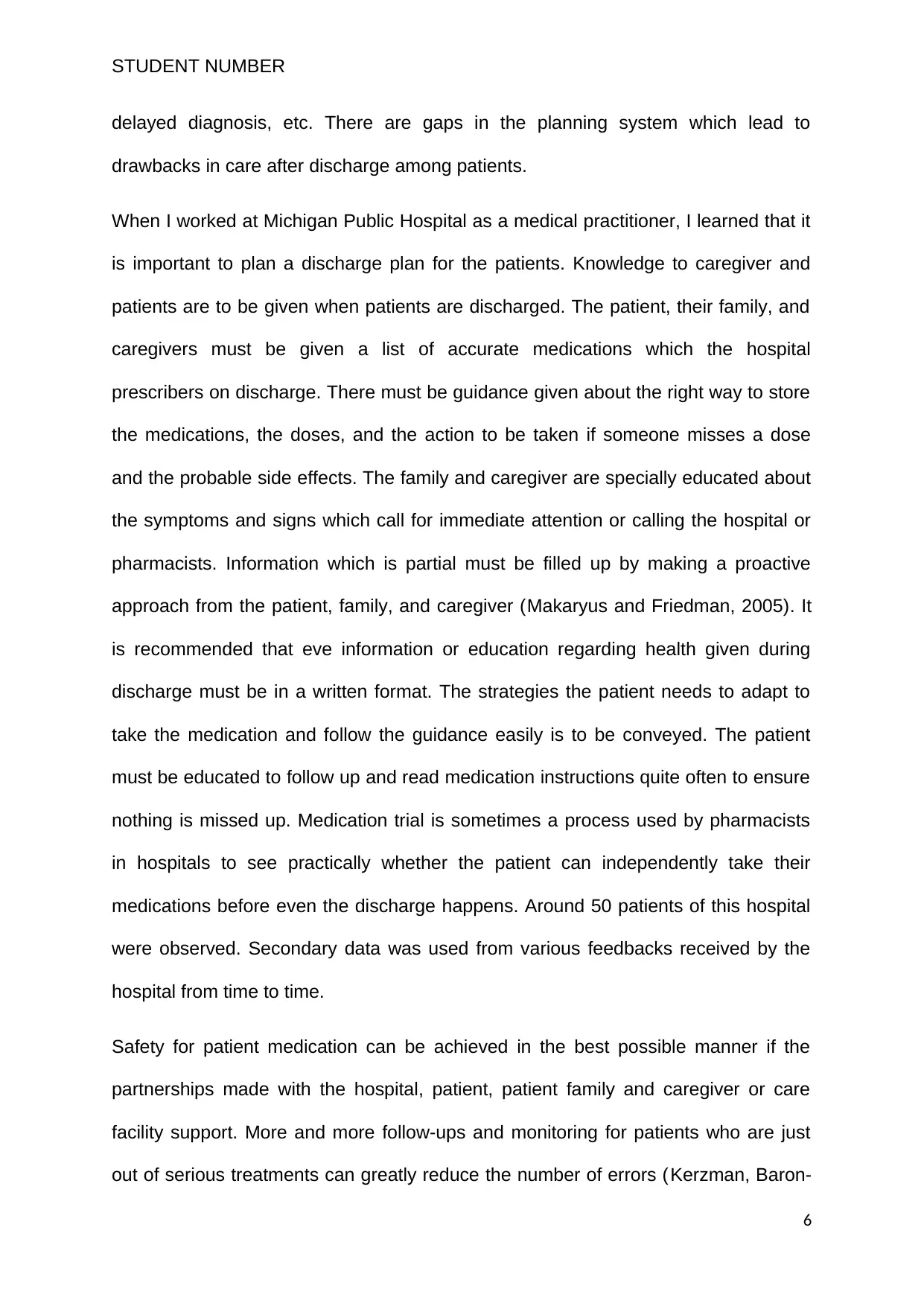
STUDENT NUMBER
delayed diagnosis, etc. There are gaps in the planning system which lead to
drawbacks in care after discharge among patients.
When I worked at Michigan Public Hospital as a medical practitioner, I learned that it
is important to plan a discharge plan for the patients. Knowledge to caregiver and
patients are to be given when patients are discharged. The patient, their family, and
caregivers must be given a list of accurate medications which the hospital
prescribers on discharge. There must be guidance given about the right way to store
the medications, the doses, and the action to be taken if someone misses a dose
and the probable side effects. The family and caregiver are specially educated about
the symptoms and signs which call for immediate attention or calling the hospital or
pharmacists. Information which is partial must be filled up by making a proactive
approach from the patient, family, and caregiver (Makaryus and Friedman, 2005). It
is recommended that eve information or education regarding health given during
discharge must be in a written format. The strategies the patient needs to adapt to
take the medication and follow the guidance easily is to be conveyed. The patient
must be educated to follow up and read medication instructions quite often to ensure
nothing is missed up. Medication trial is sometimes a process used by pharmacists
in hospitals to see practically whether the patient can independently take their
medications before even the discharge happens. Around 50 patients of this hospital
were observed. Secondary data was used from various feedbacks received by the
hospital from time to time.
Safety for patient medication can be achieved in the best possible manner if the
partnerships made with the hospital, patient, patient family and caregiver or care
facility support. More and more follow-ups and monitoring for patients who are just
out of serious treatments can greatly reduce the number of errors (Kerzman, Baron-
6
delayed diagnosis, etc. There are gaps in the planning system which lead to
drawbacks in care after discharge among patients.
When I worked at Michigan Public Hospital as a medical practitioner, I learned that it
is important to plan a discharge plan for the patients. Knowledge to caregiver and
patients are to be given when patients are discharged. The patient, their family, and
caregivers must be given a list of accurate medications which the hospital
prescribers on discharge. There must be guidance given about the right way to store
the medications, the doses, and the action to be taken if someone misses a dose
and the probable side effects. The family and caregiver are specially educated about
the symptoms and signs which call for immediate attention or calling the hospital or
pharmacists. Information which is partial must be filled up by making a proactive
approach from the patient, family, and caregiver (Makaryus and Friedman, 2005). It
is recommended that eve information or education regarding health given during
discharge must be in a written format. The strategies the patient needs to adapt to
take the medication and follow the guidance easily is to be conveyed. The patient
must be educated to follow up and read medication instructions quite often to ensure
nothing is missed up. Medication trial is sometimes a process used by pharmacists
in hospitals to see practically whether the patient can independently take their
medications before even the discharge happens. Around 50 patients of this hospital
were observed. Secondary data was used from various feedbacks received by the
hospital from time to time.
Safety for patient medication can be achieved in the best possible manner if the
partnerships made with the hospital, patient, patient family and caregiver or care
facility support. More and more follow-ups and monitoring for patients who are just
out of serious treatments can greatly reduce the number of errors (Kerzman, Baron-
6
⊘ This is a preview!⊘
Do you want full access?
Subscribe today to unlock all pages.

Trusted by 1+ million students worldwide
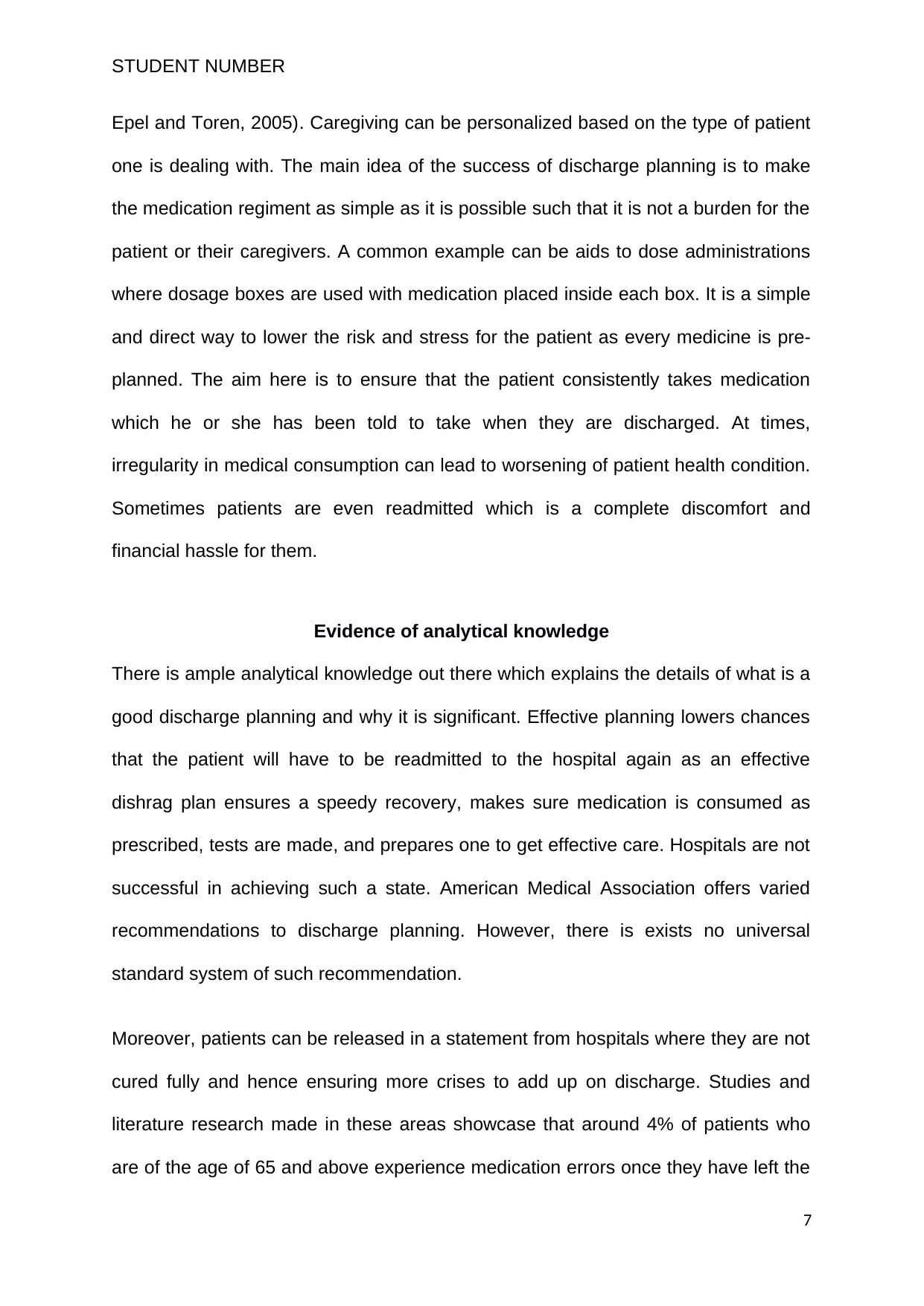
STUDENT NUMBER
Epel and Toren, 2005). Caregiving can be personalized based on the type of patient
one is dealing with. The main idea of the success of discharge planning is to make
the medication regiment as simple as it is possible such that it is not a burden for the
patient or their caregivers. A common example can be aids to dose administrations
where dosage boxes are used with medication placed inside each box. It is a simple
and direct way to lower the risk and stress for the patient as every medicine is pre-
planned. The aim here is to ensure that the patient consistently takes medication
which he or she has been told to take when they are discharged. At times,
irregularity in medical consumption can lead to worsening of patient health condition.
Sometimes patients are even readmitted which is a complete discomfort and
financial hassle for them.
Evidence of analytical knowledge
There is ample analytical knowledge out there which explains the details of what is a
good discharge planning and why it is significant. Effective planning lowers chances
that the patient will have to be readmitted to the hospital again as an effective
dishrag plan ensures a speedy recovery, makes sure medication is consumed as
prescribed, tests are made, and prepares one to get effective care. Hospitals are not
successful in achieving such a state. American Medical Association offers varied
recommendations to discharge planning. However, there is exists no universal
standard system of such recommendation.
Moreover, patients can be released in a statement from hospitals where they are not
cured fully and hence ensuring more crises to add up on discharge. Studies and
literature research made in these areas showcase that around 4% of patients who
are of the age of 65 and above experience medication errors once they have left the
7
Epel and Toren, 2005). Caregiving can be personalized based on the type of patient
one is dealing with. The main idea of the success of discharge planning is to make
the medication regiment as simple as it is possible such that it is not a burden for the
patient or their caregivers. A common example can be aids to dose administrations
where dosage boxes are used with medication placed inside each box. It is a simple
and direct way to lower the risk and stress for the patient as every medicine is pre-
planned. The aim here is to ensure that the patient consistently takes medication
which he or she has been told to take when they are discharged. At times,
irregularity in medical consumption can lead to worsening of patient health condition.
Sometimes patients are even readmitted which is a complete discomfort and
financial hassle for them.
Evidence of analytical knowledge
There is ample analytical knowledge out there which explains the details of what is a
good discharge planning and why it is significant. Effective planning lowers chances
that the patient will have to be readmitted to the hospital again as an effective
dishrag plan ensures a speedy recovery, makes sure medication is consumed as
prescribed, tests are made, and prepares one to get effective care. Hospitals are not
successful in achieving such a state. American Medical Association offers varied
recommendations to discharge planning. However, there is exists no universal
standard system of such recommendation.
Moreover, patients can be released in a statement from hospitals where they are not
cured fully and hence ensuring more crises to add up on discharge. Studies and
literature research made in these areas showcase that around 4% of patients who
are of the age of 65 and above experience medication errors once they have left the
7
Paraphrase This Document
Need a fresh take? Get an instant paraphrase of this document with our AI Paraphraser
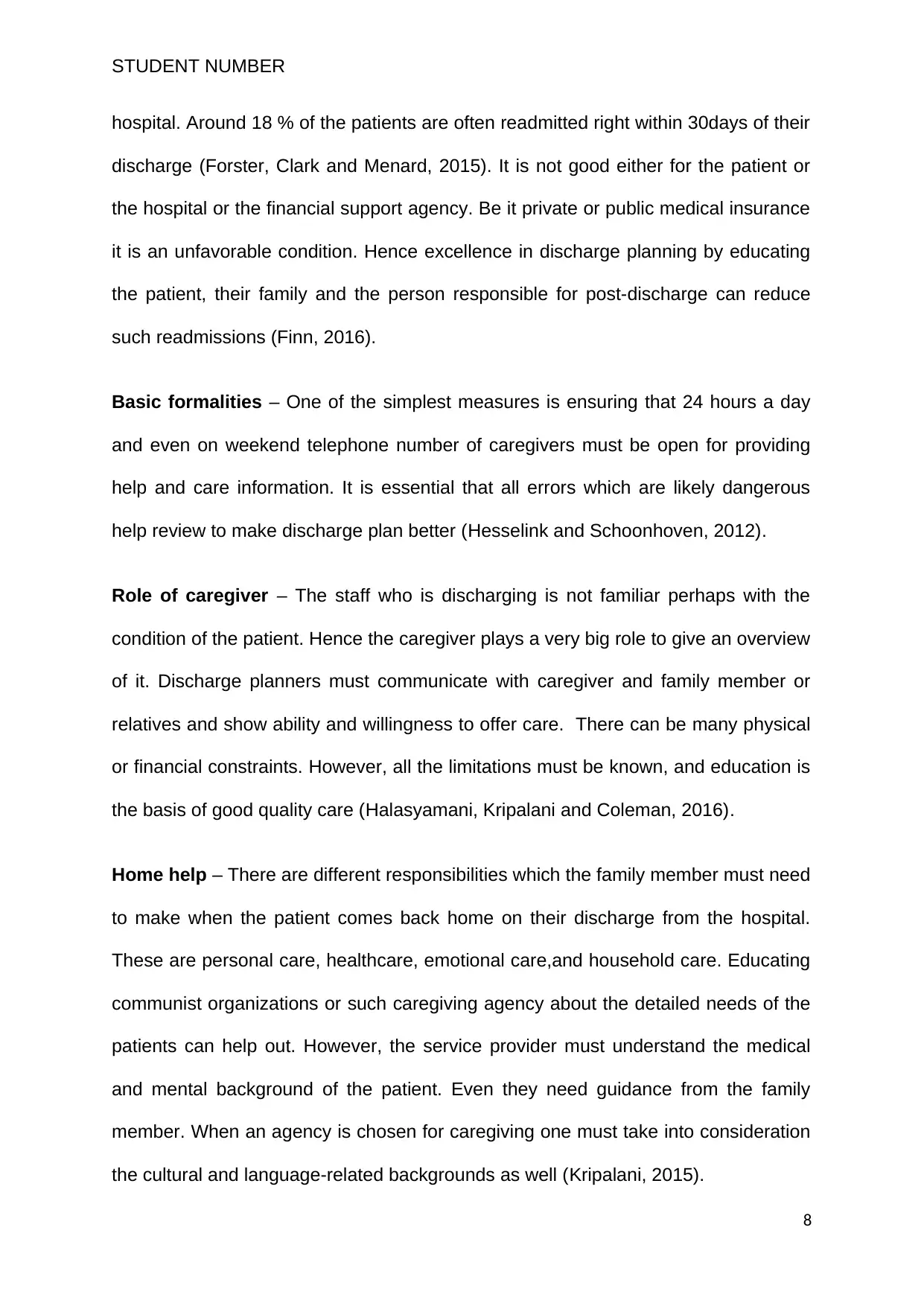
STUDENT NUMBER
hospital. Around 18 % of the patients are often readmitted right within 30days of their
discharge (Forster, Clark and Menard, 2015). It is not good either for the patient or
the hospital or the financial support agency. Be it private or public medical insurance
it is an unfavorable condition. Hence excellence in discharge planning by educating
the patient, their family and the person responsible for post-discharge can reduce
such readmissions (Finn, 2016).
Basic formalities – One of the simplest measures is ensuring that 24 hours a day
and even on weekend telephone number of caregivers must be open for providing
help and care information. It is essential that all errors which are likely dangerous
help review to make discharge plan better (Hesselink and Schoonhoven, 2012).
Role of caregiver – The staff who is discharging is not familiar perhaps with the
condition of the patient. Hence the caregiver plays a very big role to give an overview
of it. Discharge planners must communicate with caregiver and family member or
relatives and show ability and willingness to offer care. There can be many physical
or financial constraints. However, all the limitations must be known, and education is
the basis of good quality care (Halasyamani, Kripalani and Coleman, 2016).
Home help – There are different responsibilities which the family member must need
to make when the patient comes back home on their discharge from the hospital.
These are personal care, healthcare, emotional care,and household care. Educating
communist organizations or such caregiving agency about the detailed needs of the
patients can help out. However, the service provider must understand the medical
and mental background of the patient. Even they need guidance from the family
member. When an agency is chosen for caregiving one must take into consideration
the cultural and language-related backgrounds as well (Kripalani, 2015).
8
hospital. Around 18 % of the patients are often readmitted right within 30days of their
discharge (Forster, Clark and Menard, 2015). It is not good either for the patient or
the hospital or the financial support agency. Be it private or public medical insurance
it is an unfavorable condition. Hence excellence in discharge planning by educating
the patient, their family and the person responsible for post-discharge can reduce
such readmissions (Finn, 2016).
Basic formalities – One of the simplest measures is ensuring that 24 hours a day
and even on weekend telephone number of caregivers must be open for providing
help and care information. It is essential that all errors which are likely dangerous
help review to make discharge plan better (Hesselink and Schoonhoven, 2012).
Role of caregiver – The staff who is discharging is not familiar perhaps with the
condition of the patient. Hence the caregiver plays a very big role to give an overview
of it. Discharge planners must communicate with caregiver and family member or
relatives and show ability and willingness to offer care. There can be many physical
or financial constraints. However, all the limitations must be known, and education is
the basis of good quality care (Halasyamani, Kripalani and Coleman, 2016).
Home help – There are different responsibilities which the family member must need
to make when the patient comes back home on their discharge from the hospital.
These are personal care, healthcare, emotional care,and household care. Educating
communist organizations or such caregiving agency about the detailed needs of the
patients can help out. However, the service provider must understand the medical
and mental background of the patient. Even they need guidance from the family
member. When an agency is chosen for caregiving one must take into consideration
the cultural and language-related backgrounds as well (Kripalani, 2015).
8
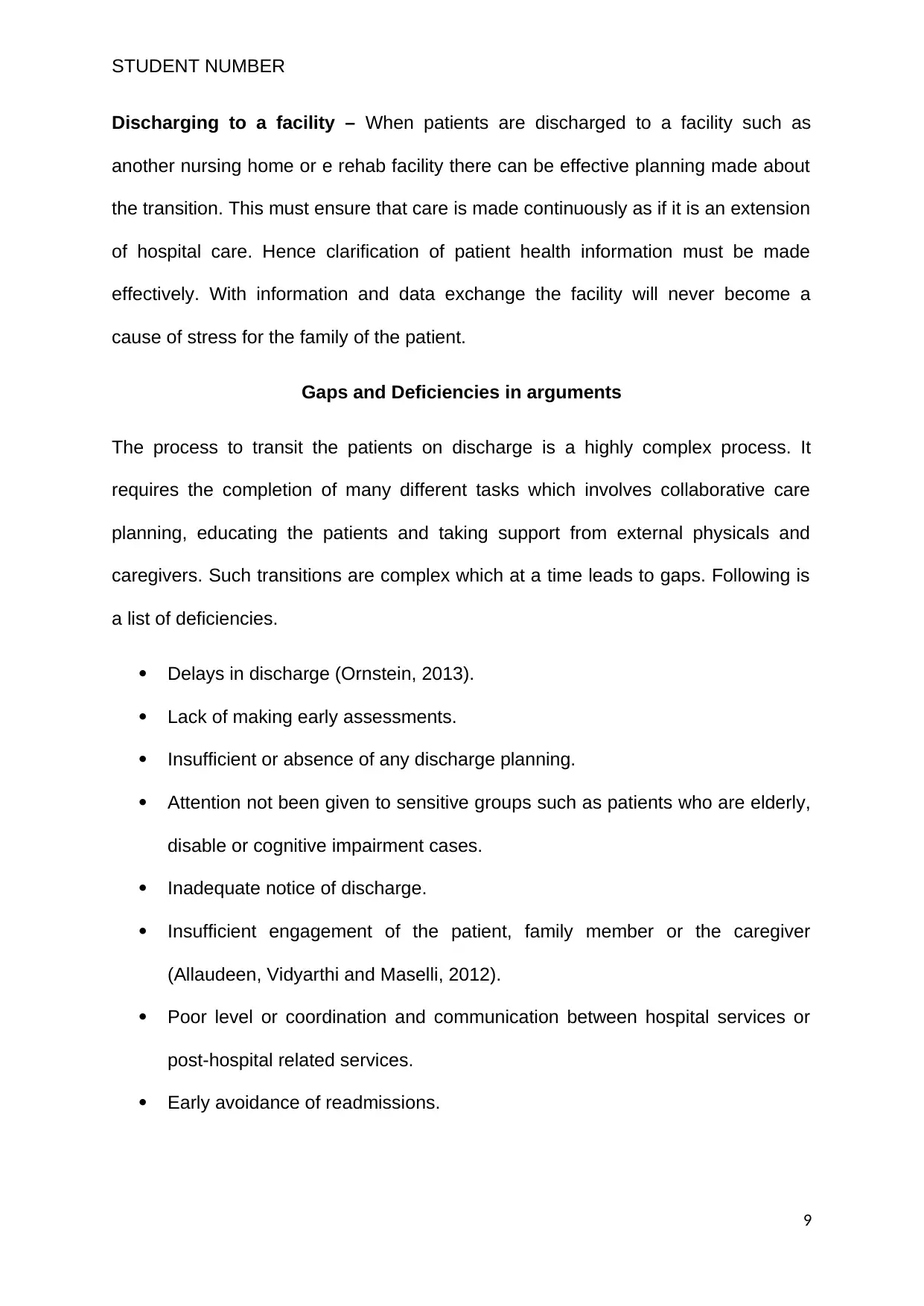
STUDENT NUMBER
Discharging to a facility – When patients are discharged to a facility such as
another nursing home or e rehab facility there can be effective planning made about
the transition. This must ensure that care is made continuously as if it is an extension
of hospital care. Hence clarification of patient health information must be made
effectively. With information and data exchange the facility will never become a
cause of stress for the family of the patient.
Gaps and Deficiencies in arguments
The process to transit the patients on discharge is a highly complex process. It
requires the completion of many different tasks which involves collaborative care
planning, educating the patients and taking support from external physicals and
caregivers. Such transitions are complex which at a time leads to gaps. Following is
a list of deficiencies.
Delays in discharge (Ornstein, 2013).
Lack of making early assessments.
Insufficient or absence of any discharge planning.
Attention not been given to sensitive groups such as patients who are elderly,
disable or cognitive impairment cases.
Inadequate notice of discharge.
Insufficient engagement of the patient, family member or the caregiver
(Allaudeen, Vidyarthi and Maselli, 2012).
Poor level or coordination and communication between hospital services or
post-hospital related services.
Early avoidance of readmissions.
9
Discharging to a facility – When patients are discharged to a facility such as
another nursing home or e rehab facility there can be effective planning made about
the transition. This must ensure that care is made continuously as if it is an extension
of hospital care. Hence clarification of patient health information must be made
effectively. With information and data exchange the facility will never become a
cause of stress for the family of the patient.
Gaps and Deficiencies in arguments
The process to transit the patients on discharge is a highly complex process. It
requires the completion of many different tasks which involves collaborative care
planning, educating the patients and taking support from external physicals and
caregivers. Such transitions are complex which at a time leads to gaps. Following is
a list of deficiencies.
Delays in discharge (Ornstein, 2013).
Lack of making early assessments.
Insufficient or absence of any discharge planning.
Attention not been given to sensitive groups such as patients who are elderly,
disable or cognitive impairment cases.
Inadequate notice of discharge.
Insufficient engagement of the patient, family member or the caregiver
(Allaudeen, Vidyarthi and Maselli, 2012).
Poor level or coordination and communication between hospital services or
post-hospital related services.
Early avoidance of readmissions.
9
⊘ This is a preview!⊘
Do you want full access?
Subscribe today to unlock all pages.

Trusted by 1+ million students worldwide
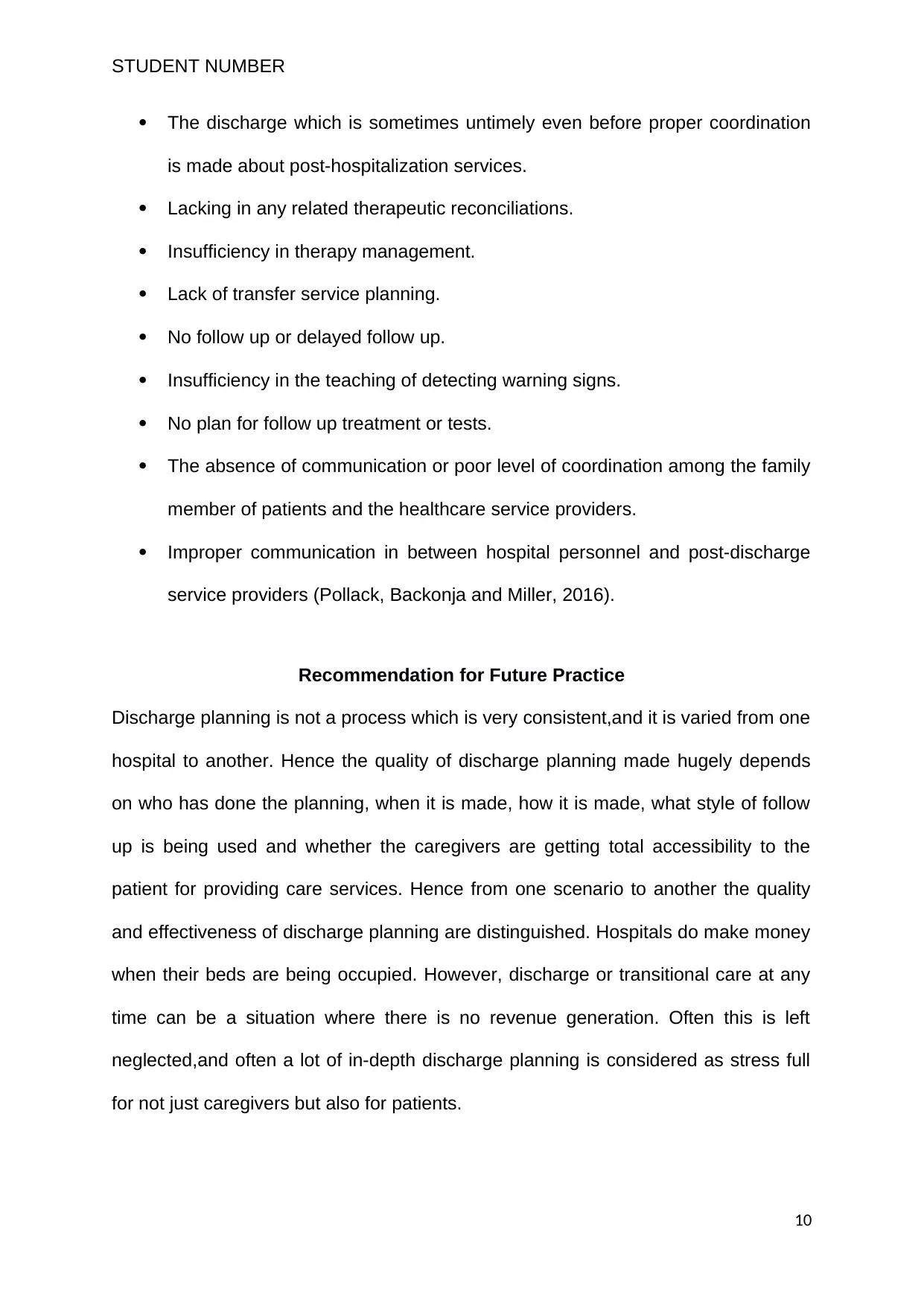
STUDENT NUMBER
The discharge which is sometimes untimely even before proper coordination
is made about post-hospitalization services.
Lacking in any related therapeutic reconciliations.
Insufficiency in therapy management.
Lack of transfer service planning.
No follow up or delayed follow up.
Insufficiency in the teaching of detecting warning signs.
No plan for follow up treatment or tests.
The absence of communication or poor level of coordination among the family
member of patients and the healthcare service providers.
Improper communication in between hospital personnel and post-discharge
service providers (Pollack, Backonja and Miller, 2016).
Recommendation for Future Practice
Discharge planning is not a process which is very consistent,and it is varied from one
hospital to another. Hence the quality of discharge planning made hugely depends
on who has done the planning, when it is made, how it is made, what style of follow
up is being used and whether the caregivers are getting total accessibility to the
patient for providing care services. Hence from one scenario to another the quality
and effectiveness of discharge planning are distinguished. Hospitals do make money
when their beds are being occupied. However, discharge or transitional care at any
time can be a situation where there is no revenue generation. Often this is left
neglected,and often a lot of in-depth discharge planning is considered as stress full
for not just caregivers but also for patients.
10
The discharge which is sometimes untimely even before proper coordination
is made about post-hospitalization services.
Lacking in any related therapeutic reconciliations.
Insufficiency in therapy management.
Lack of transfer service planning.
No follow up or delayed follow up.
Insufficiency in the teaching of detecting warning signs.
No plan for follow up treatment or tests.
The absence of communication or poor level of coordination among the family
member of patients and the healthcare service providers.
Improper communication in between hospital personnel and post-discharge
service providers (Pollack, Backonja and Miller, 2016).
Recommendation for Future Practice
Discharge planning is not a process which is very consistent,and it is varied from one
hospital to another. Hence the quality of discharge planning made hugely depends
on who has done the planning, when it is made, how it is made, what style of follow
up is being used and whether the caregivers are getting total accessibility to the
patient for providing care services. Hence from one scenario to another the quality
and effectiveness of discharge planning are distinguished. Hospitals do make money
when their beds are being occupied. However, discharge or transitional care at any
time can be a situation where there is no revenue generation. Often this is left
neglected,and often a lot of in-depth discharge planning is considered as stress full
for not just caregivers but also for patients.
10
Paraphrase This Document
Need a fresh take? Get an instant paraphrase of this document with our AI Paraphraser
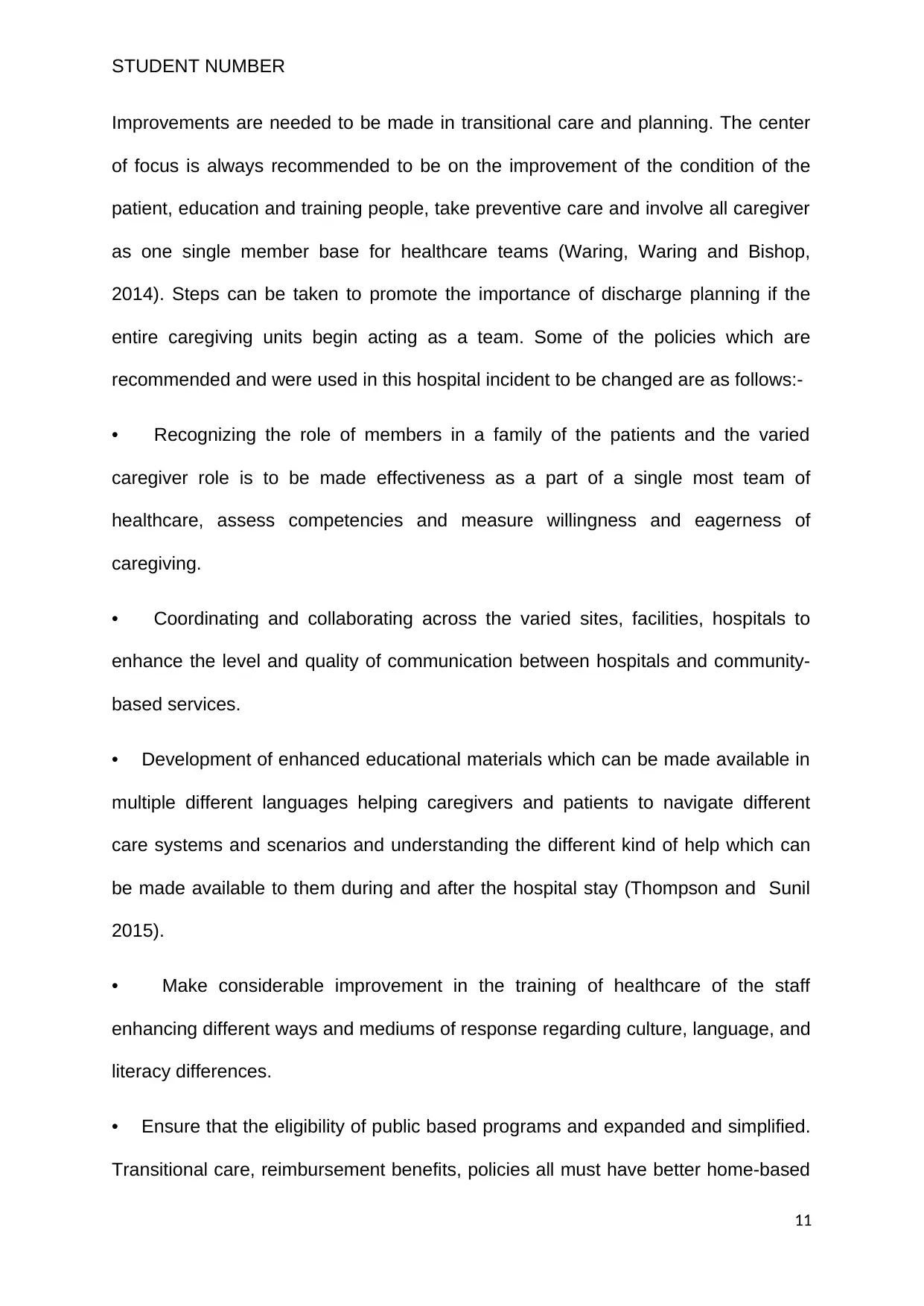
STUDENT NUMBER
Improvements are needed to be made in transitional care and planning. The center
of focus is always recommended to be on the improvement of the condition of the
patient, education and training people, take preventive care and involve all caregiver
as one single member base for healthcare teams (Waring, Waring and Bishop,
2014). Steps can be taken to promote the importance of discharge planning if the
entire caregiving units begin acting as a team. Some of the policies which are
recommended and were used in this hospital incident to be changed are as follows:-
• Recognizing the role of members in a family of the patients and the varied
caregiver role is to be made effectiveness as a part of a single most team of
healthcare, assess competencies and measure willingness and eagerness of
caregiving.
• Coordinating and collaborating across the varied sites, facilities, hospitals to
enhance the level and quality of communication between hospitals and community-
based services.
• Development of enhanced educational materials which can be made available in
multiple different languages helping caregivers and patients to navigate different
care systems and scenarios and understanding the different kind of help which can
be made available to them during and after the hospital stay (Thompson and Sunil
2015).
• Make considerable improvement in the training of healthcare of the staff
enhancing different ways and mediums of response regarding culture, language, and
literacy differences.
• Ensure that the eligibility of public based programs and expanded and simplified.
Transitional care, reimbursement benefits, policies all must have better home-based
11
Improvements are needed to be made in transitional care and planning. The center
of focus is always recommended to be on the improvement of the condition of the
patient, education and training people, take preventive care and involve all caregiver
as one single member base for healthcare teams (Waring, Waring and Bishop,
2014). Steps can be taken to promote the importance of discharge planning if the
entire caregiving units begin acting as a team. Some of the policies which are
recommended and were used in this hospital incident to be changed are as follows:-
• Recognizing the role of members in a family of the patients and the varied
caregiver role is to be made effectiveness as a part of a single most team of
healthcare, assess competencies and measure willingness and eagerness of
caregiving.
• Coordinating and collaborating across the varied sites, facilities, hospitals to
enhance the level and quality of communication between hospitals and community-
based services.
• Development of enhanced educational materials which can be made available in
multiple different languages helping caregivers and patients to navigate different
care systems and scenarios and understanding the different kind of help which can
be made available to them during and after the hospital stay (Thompson and Sunil
2015).
• Make considerable improvement in the training of healthcare of the staff
enhancing different ways and mediums of response regarding culture, language, and
literacy differences.
• Ensure that the eligibility of public based programs and expanded and simplified.
Transitional care, reimbursement benefits, policies all must have better home-based
11
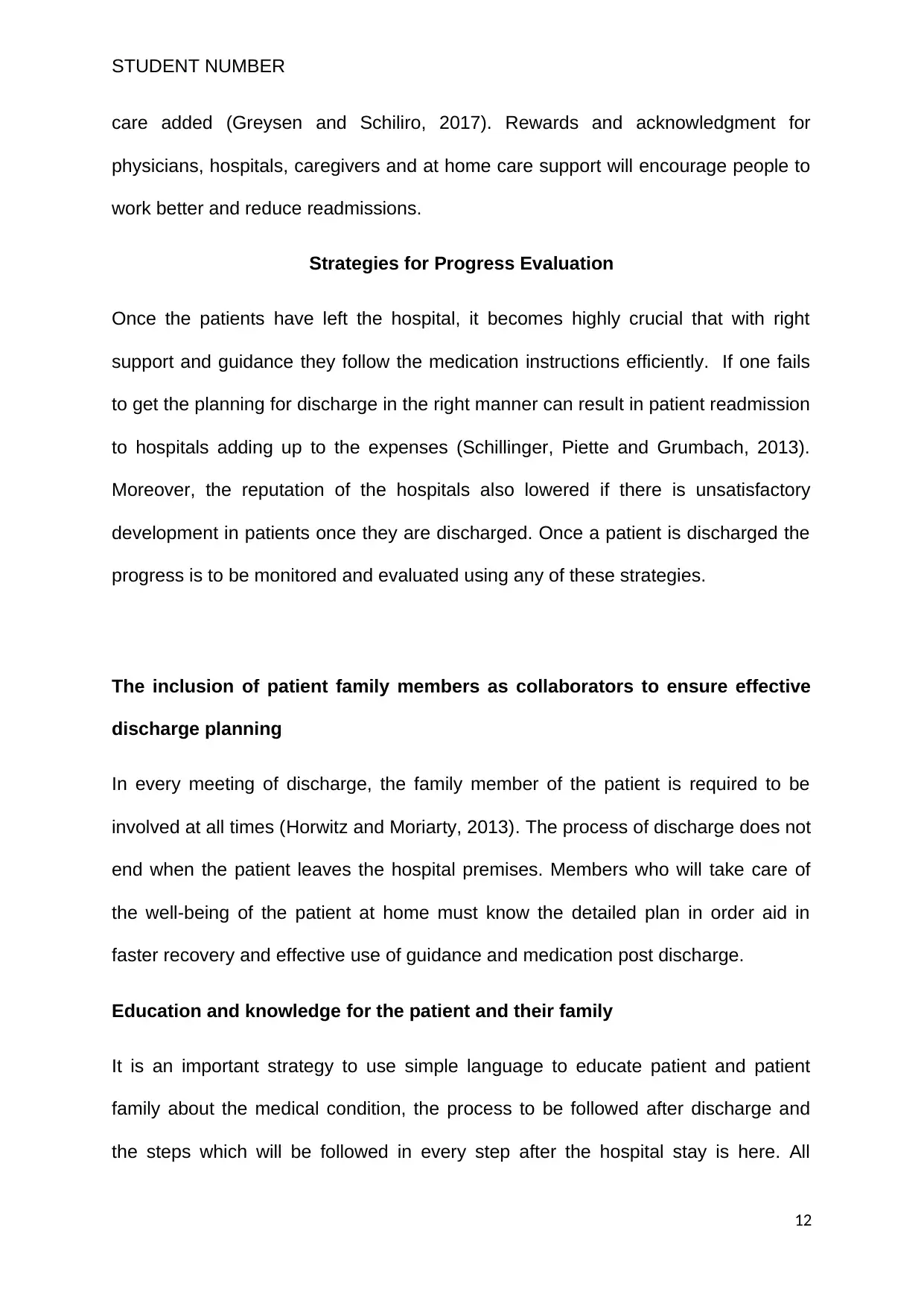
STUDENT NUMBER
care added (Greysen and Schiliro, 2017). Rewards and acknowledgment for
physicians, hospitals, caregivers and at home care support will encourage people to
work better and reduce readmissions.
Strategies for Progress Evaluation
Once the patients have left the hospital, it becomes highly crucial that with right
support and guidance they follow the medication instructions efficiently. If one fails
to get the planning for discharge in the right manner can result in patient readmission
to hospitals adding up to the expenses (Schillinger, Piette and Grumbach, 2013).
Moreover, the reputation of the hospitals also lowered if there is unsatisfactory
development in patients once they are discharged. Once a patient is discharged the
progress is to be monitored and evaluated using any of these strategies.
The inclusion of patient family members as collaborators to ensure effective
discharge planning
In every meeting of discharge, the family member of the patient is required to be
involved at all times (Horwitz and Moriarty, 2013). The process of discharge does not
end when the patient leaves the hospital premises. Members who will take care of
the well-being of the patient at home must know the detailed plan in order aid in
faster recovery and effective use of guidance and medication post discharge.
Education and knowledge for the patient and their family
It is an important strategy to use simple language to educate patient and patient
family about the medical condition, the process to be followed after discharge and
the steps which will be followed in every step after the hospital stay is here. All
12
care added (Greysen and Schiliro, 2017). Rewards and acknowledgment for
physicians, hospitals, caregivers and at home care support will encourage people to
work better and reduce readmissions.
Strategies for Progress Evaluation
Once the patients have left the hospital, it becomes highly crucial that with right
support and guidance they follow the medication instructions efficiently. If one fails
to get the planning for discharge in the right manner can result in patient readmission
to hospitals adding up to the expenses (Schillinger, Piette and Grumbach, 2013).
Moreover, the reputation of the hospitals also lowered if there is unsatisfactory
development in patients once they are discharged. Once a patient is discharged the
progress is to be monitored and evaluated using any of these strategies.
The inclusion of patient family members as collaborators to ensure effective
discharge planning
In every meeting of discharge, the family member of the patient is required to be
involved at all times (Horwitz and Moriarty, 2013). The process of discharge does not
end when the patient leaves the hospital premises. Members who will take care of
the well-being of the patient at home must know the detailed plan in order aid in
faster recovery and effective use of guidance and medication post discharge.
Education and knowledge for the patient and their family
It is an important strategy to use simple language to educate patient and patient
family about the medical condition, the process to be followed after discharge and
the steps which will be followed in every step after the hospital stay is here. All
12
⊘ This is a preview!⊘
Do you want full access?
Subscribe today to unlock all pages.

Trusted by 1+ million students worldwide
1 out of 20
Related Documents
Your All-in-One AI-Powered Toolkit for Academic Success.
+13062052269
info@desklib.com
Available 24*7 on WhatsApp / Email
![[object Object]](/_next/static/media/star-bottom.7253800d.svg)
Unlock your academic potential
Copyright © 2020–2025 A2Z Services. All Rights Reserved. Developed and managed by ZUCOL.





